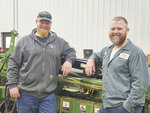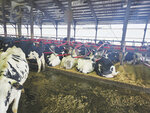


REEDSBURG, Wis. — Kinnamon Ridge Dairy has seen a lot of upgrades since the first generation of Whites began dairying in the 1950s with 30 wooden stanchions.
Ryan and Nate White manage to continually make upgrades by being tech-savvy and penny-wise.
“I’ve always been a firm believer that we should be able to technically support the things we have,” Nate said. “(If you make) improvements 50 cents on the dollar or 30 cents on the dollar compared to dealer prices, you can do it 30% sooner, and payback is faster.”
Ryan agreed.
“You can push the envelope on size that way,” he said.
Ryan and Nate operate the 860-cow dairy near Reedsburg along with their parents, Jerry and Linda, and employees. Their milk is shipped to the Grande Cheese Company. Cows are milked three times a day in a parlor and housed in sand-bedded free stalls.
Jerry is the main herd manager and works with employees to complete herdsman tasks. Cows are monitored with activity leg bands and sort gate technology. Linda manages all business aspects and bookkeeping. Early in her career, she acquired herdsman skills, which she has passed on to her employees to save on veterinarian costs.
Nate oversees the crops, planting, a portion of the harvesting, part of the shop and employee management. Ryan is responsible for heavy repairs in the shop and feed management with the nutritionist. Ryan is also developing financial planning skills and is doing risk management for incoming feed and milk sales.
The brothers are always considering their next upgrade, sometimes taking years to plan and acquire supplies for a project. Nate likes to hunt for bargains and credits Ryan for his technical skills.
One recent project includes a grain grinding facility built last year near the dairy.
It started when a local mill went out of business, and Ryan purchased the bins. The bins sat on the ground for two years while they pieced together the rest of the supplies. Some items were new, and an electrician was hired to wire according to code. Ryan programmed all the electrical controls and programmed the programmable logic controller that runs the system.
“If we had to go out and set that system up with new bins and everything, we’re 50 cents on the dollar for cost,” Ryan said. “The big pieces we got used had a lot of life left in them.”
Upgrades to the manure-hauling equipment were done with similar attention to economic efficiency.
The barns are cleaned using a flush system. Pens are cleaned with recycled manure liquid and gravity, to reduce the use of mechanical cleaning. Manure liquid is applied with a drag hose to minimize road traffic and field compaction.
The first drag-line system was purchased in 2013. Last year, they invested in upgrades, which included high-wear pumps and a remote monitoring system that connects to their phones, allowing for mobile operation and monitoring of the pumps.
This investment also included adding mileage to their manure hoses, allowing them to cover up to 2.5 miles and essentially reach all of their contiguous owned and leased land.
“It’s been more effective than it’s ever been,” Ryan said. “We took our old pumps and put new parts on them.”
Cow comfort has not been overlooked while making upgrades. This year, a section of 20-year-old, metal free stalls was replaced with Easyfix flexible stalls.
They replaced about three dozen stalls in 2022 and had such success with them that they did another 116 this year. The stalls are constructed of half-inch tubing with a quarter-inch neck rail. They are more flexible than metal stalls and have memory. If they are bumped with equipment or a cow pushes them, they pop back to their original location.
The stalls were purchased from a dairy equipment dealer and installation was done in-house.
The brothers have spent the winter going through equipment to get ready for spring planting. As always, they are planning their projects so they can be on the hunt for bargains. They hope to increase feed storage and transition from sand bedding to fiber-separated bedding. They believe that would bring a lot of efficiencies.
Nate said it is important to have goals to be ready when opportunities arise.
“No plan is perfect, but knowing what moves you want to make and having an idea of what you’re trying to improve is important,” Nate said.
Comments
No comments on this item Please log in to comment by clicking here